Notebook and postcards written by Florence Hobbes, c 1916-1917 - Part 3
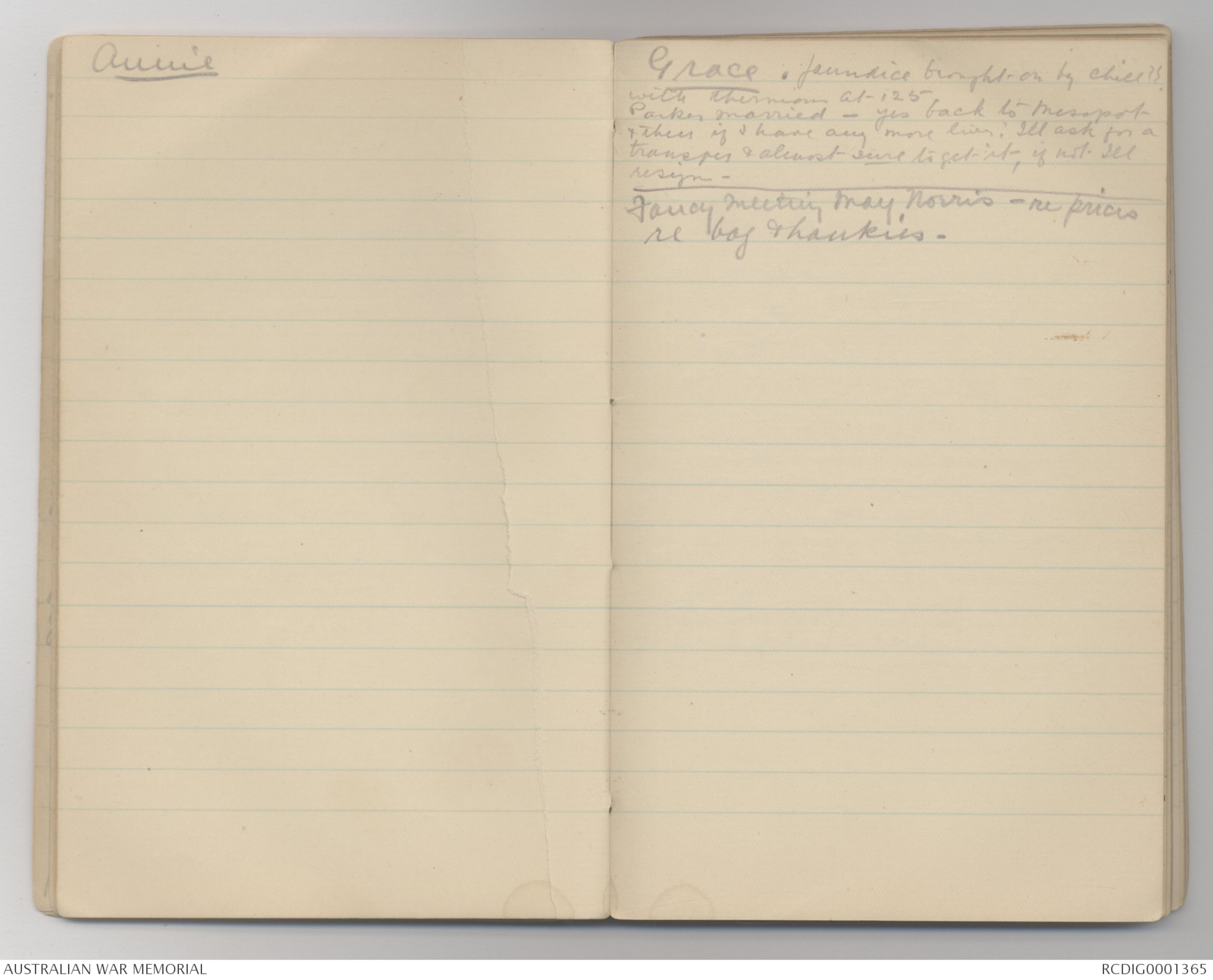
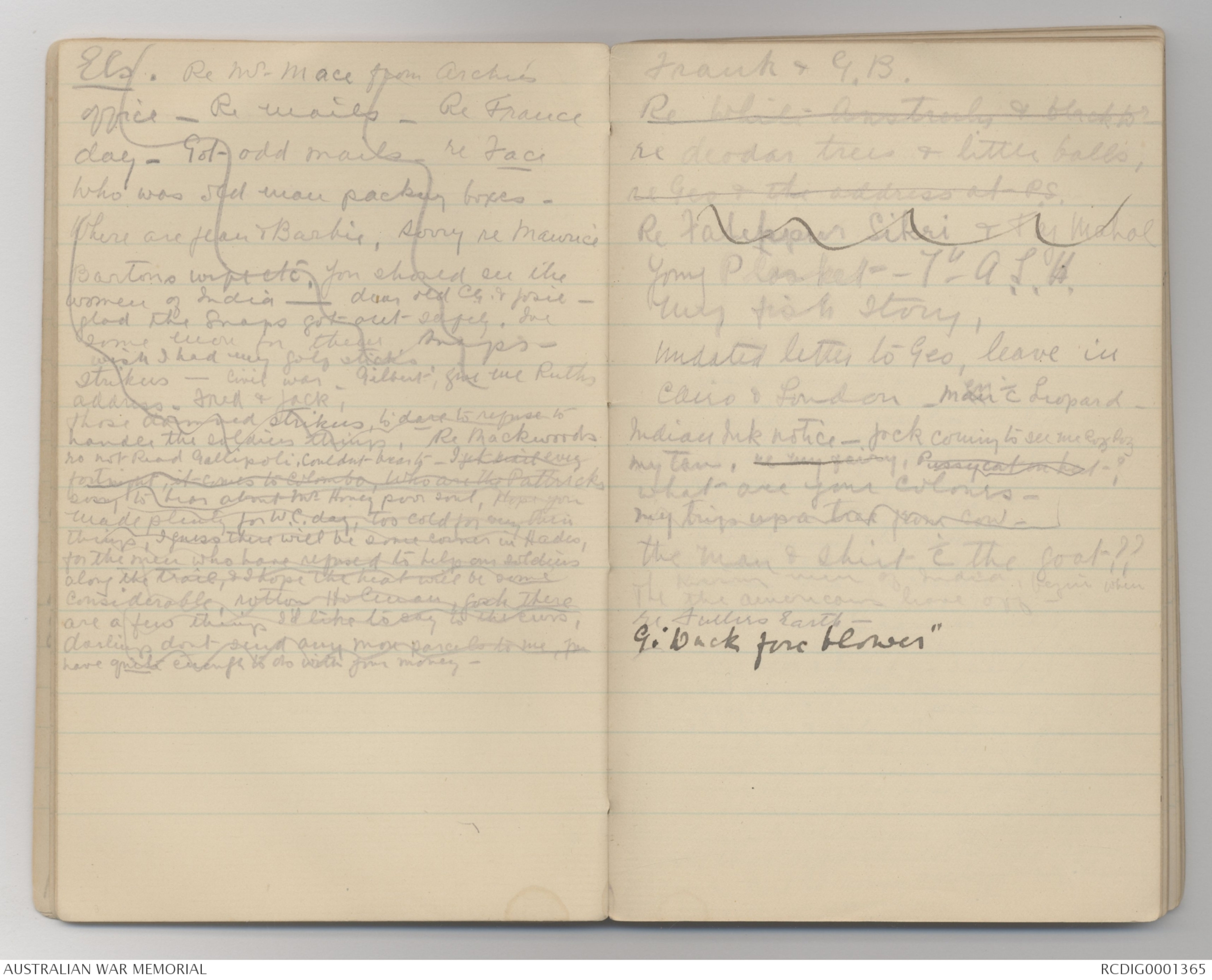
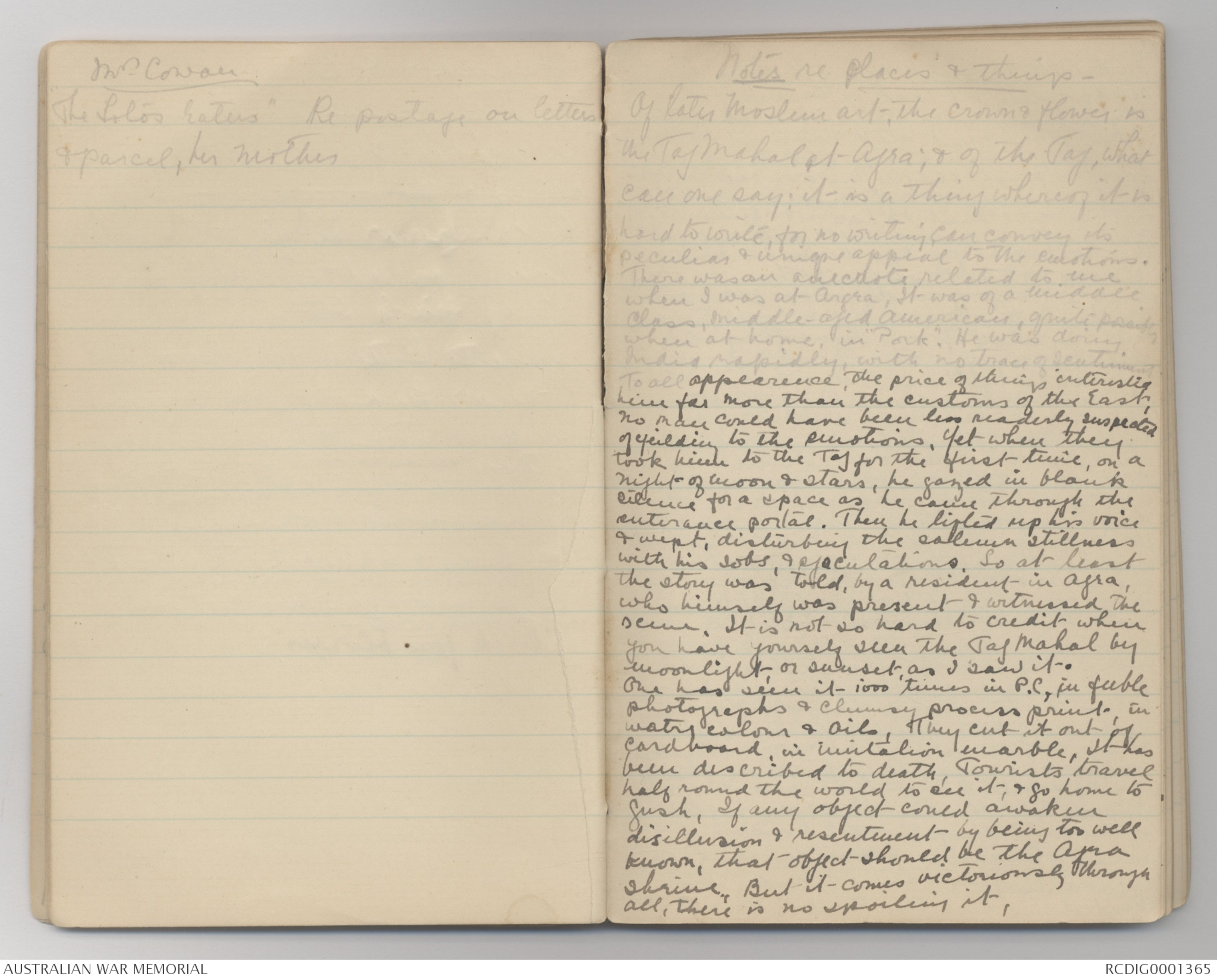
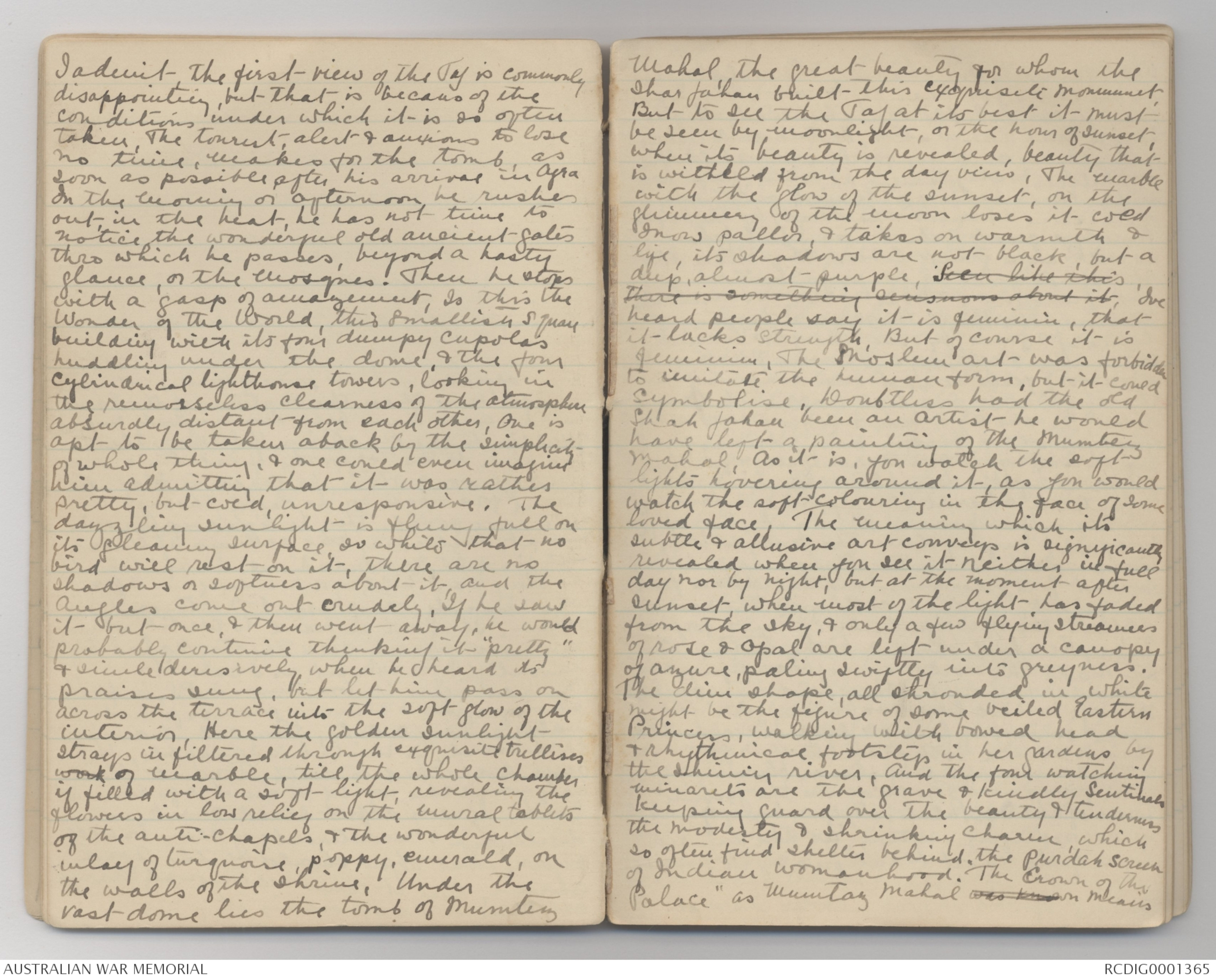
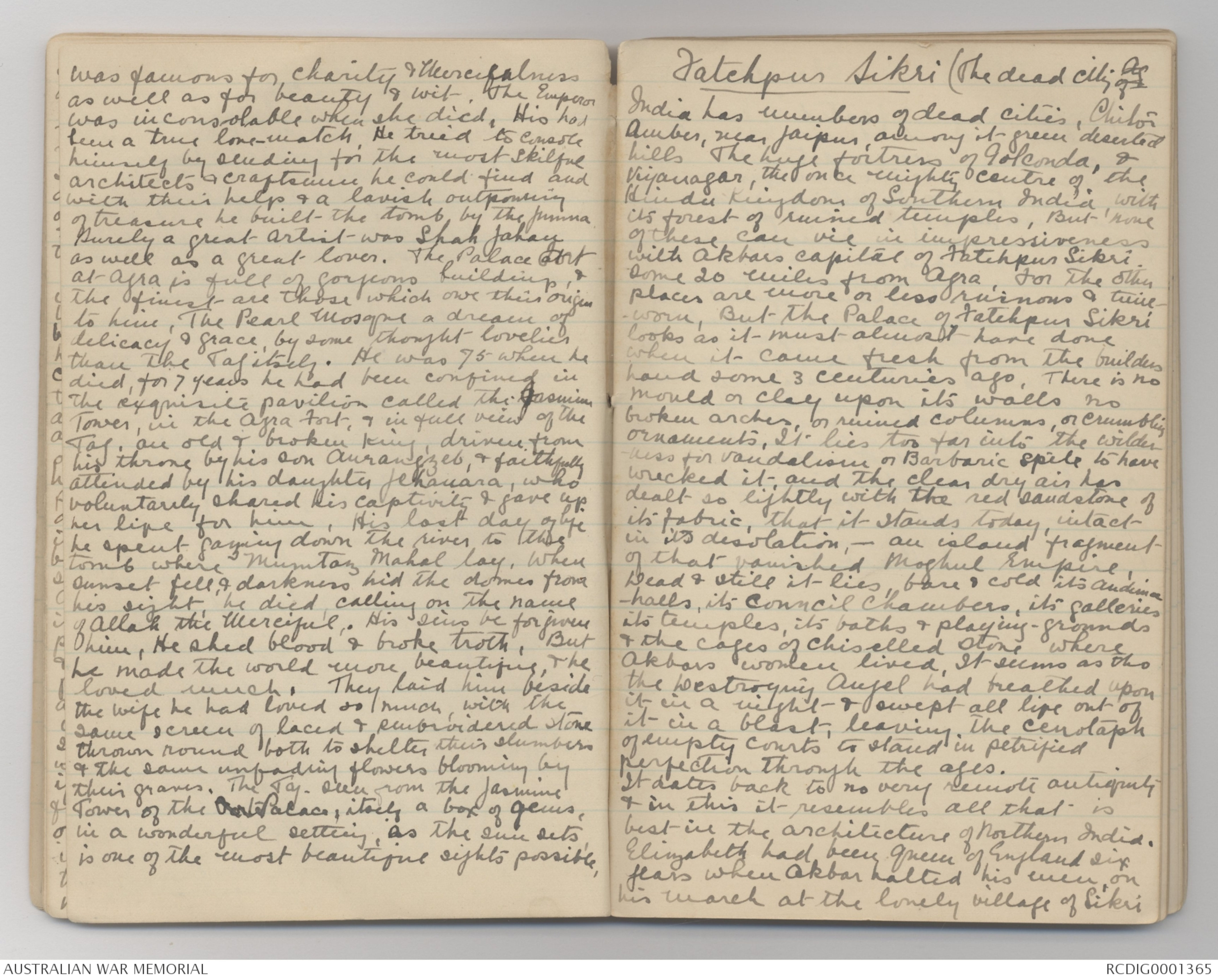


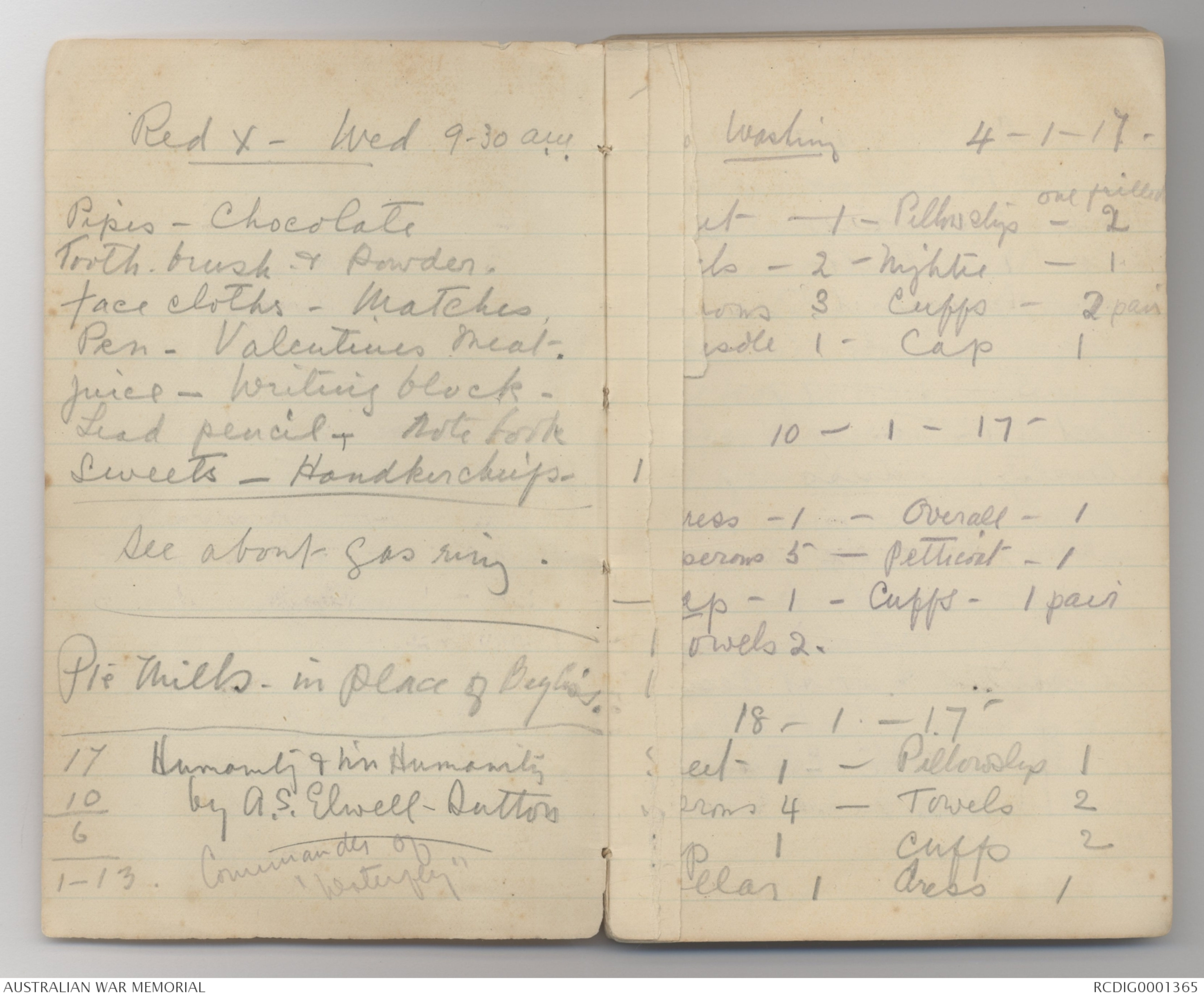
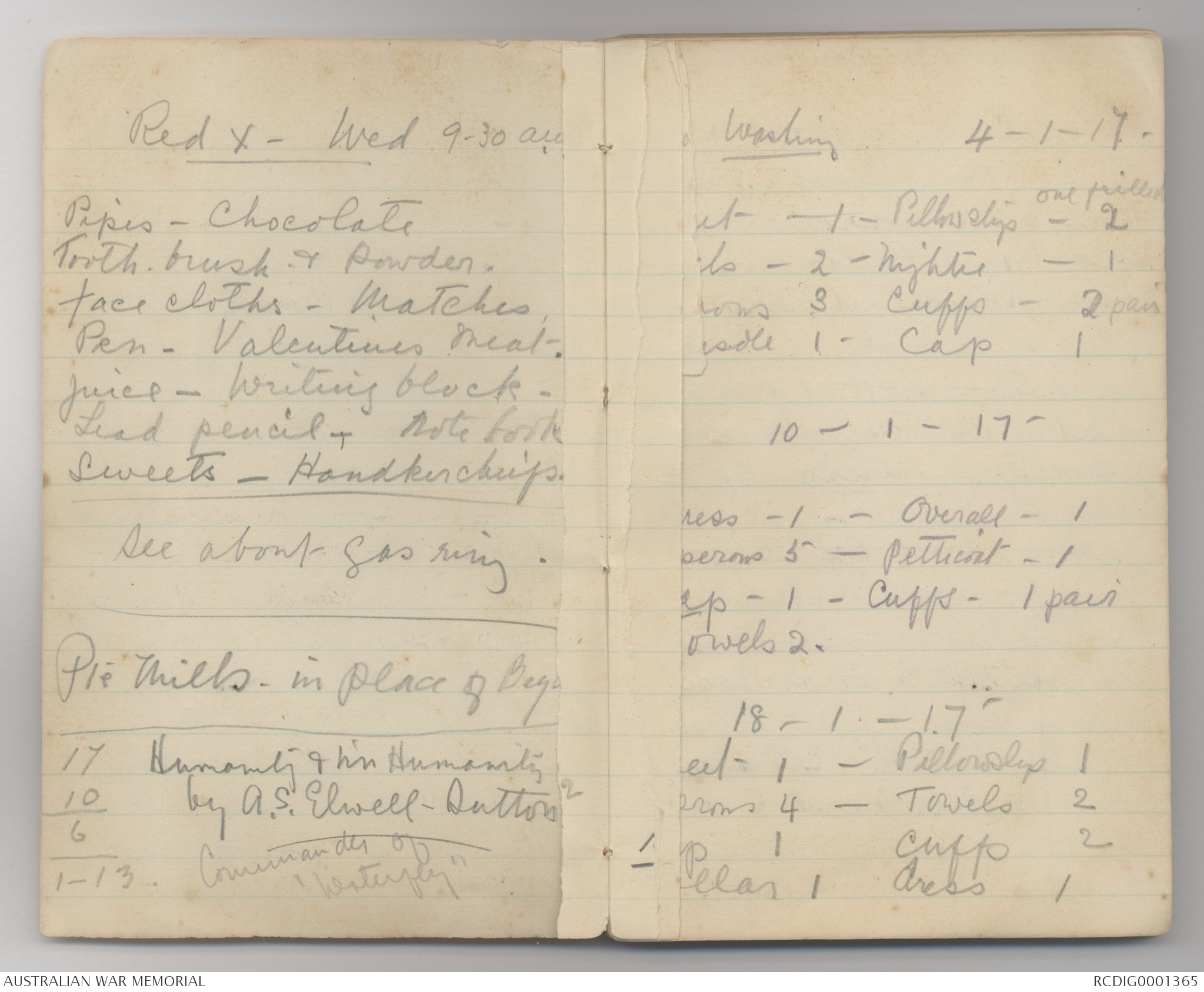
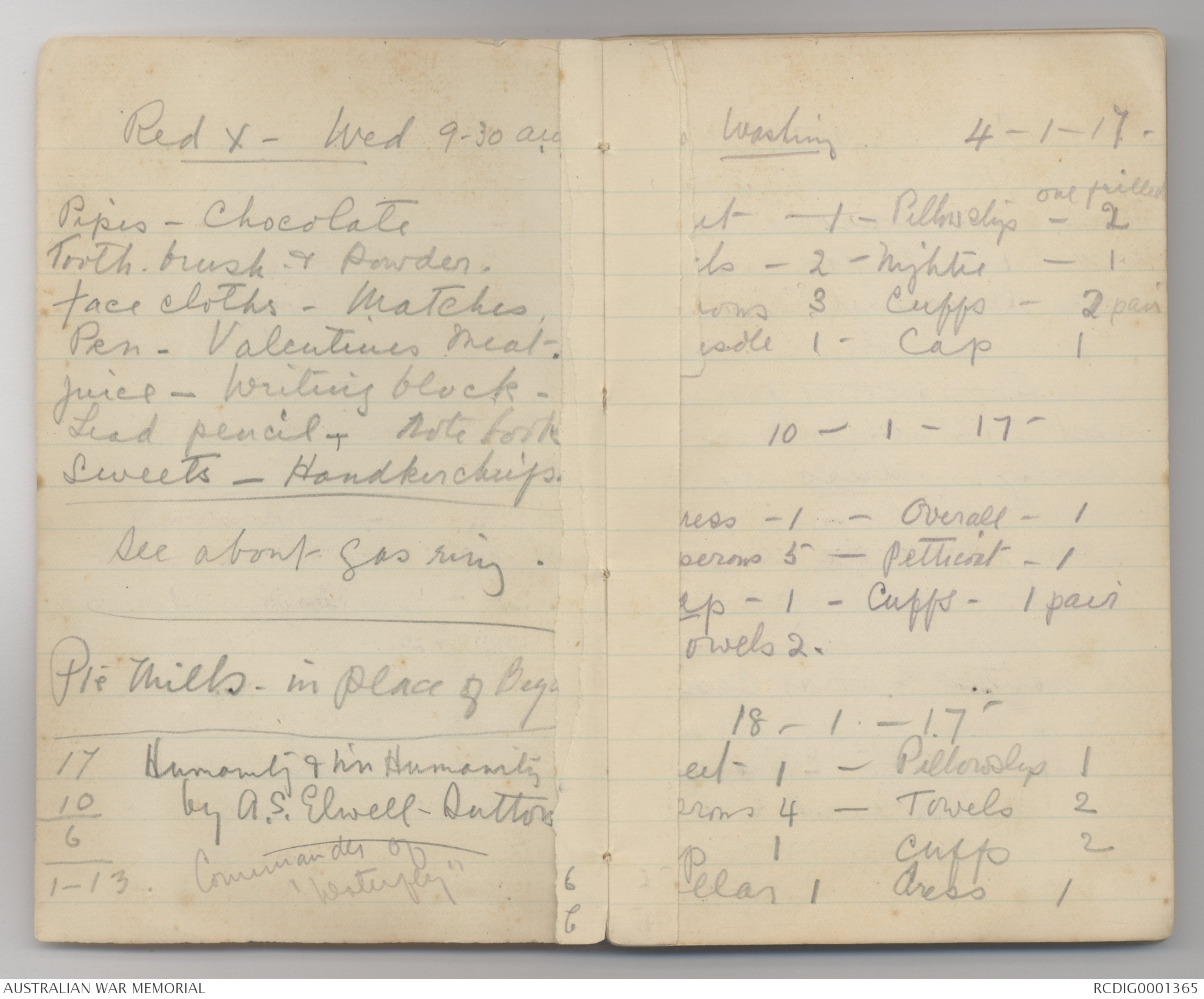
Annie
Grace. Jaundice brought on by chill ??
with Chermain at 125
Parker married - yes back to Messpot
& then if I have any more liver: I'll ask for a
transfer & almost sure to get it, if not I'll
resign -
Fancy meeting May Morris - re prices
re bag & hankies -
Els.. Re Mr Mace from Archie's
office - Re mails - Re France
day - Got odd mails re Faci
who was still now packing boxes -
Where are Jean & Barbie, Sorry re Maurice
Bartons wife etc. You should see the
women of India - dear old C.G & Josie -
glad the Snaps got out safely. I've
some more for these Snaps -
wish I had my golf sticks.
Strikers - Civil war. Gilbert give me Ruths
address. Fred & Jack,
Those damned strikers, to dare to refuse to
handle the soldiers things. Re Mackwoods
so not Read Gallipoli, couldn't bear to - I get mail every
fortnight, it comes to Colombo, who are the Pattricks
sorry to hear about Mrs Honey poor soul, Hope you
made plenty for W.C, day, too cold for very thin
things, I guess there will be some corner in Hades,
for the men who have refused to help our soldiers
along the trail, & I hope the heat will be some
considerable, rotten [[?]] Germany, gosh there
are a few things I'd like to say to the huns,
darling don't send any more parcels to me, you
have quite enough to do with your money -
Frank & G.B.
Re White - Australia & black to
thee [[deodar?]] trees & little balls,
re Geo & the address at P.S.
Re Fatepour Sikri & Taj Mahal
Young Plasket - 7th A.I. F.
My fish story,
Undated letters to Geo, leave in
Cairo & London - manen w Leopard -
Indian Ink notice - Jock coming to see Mr Roxby
my tan re my going, Pussy cat on heat?
what are your colours -
my trips up a trek from xxxx-
the man & shirt w the goat??
Kissing men of India (begin when
The the americans leave off
re Fullers Earth
G: back fire blower"
Mrs Cowan
"The Lotos Eaters" Re postage on letters
& parcel, her mothers
Notes re places & things -
Of later Moslem art, the crown & flower is
the Taj Mahal at Agra; & of the Taj, what
can one say; it is a thing whereof it is
hard to write, for no writing can convey its
peculiar & unique appeal to the emotions.
There was an anecdote related to me
when I was at Argra, It was of a middle
class, middle-aged American, quite possibly
when at home, in "Pork". He was doing
India rapidly, with no trace of sentiment.
To all appearance, the price of things interesting
him far more than the customs of the East,
no man could have been less readerly suspected
of yielding to the emotions. Yet when they
took him to the Taj for the first time, on a
night of moon & stars, he gazed in blank
silence for a space as he came through the
entrance portal. There he lifted up his voice
& wept, disturbing the solemn stillness
with his sobs, & ejaculations. So at least
the story was told, by a resident - in Agra,
who himself was present - & witnessed the
scene. It is not so hard to credit when
you have yourself seen the Taj Mahal by
moonlight, or sunset, as I saw it.
One has seen it -1000 times in P.C, in feeble
photographs & clumsy process print. in
watry colour & oils, They cut it out of
cardboard, in imitation marble. It has
been described to death. Tourists travel
half round the world to see it, & go home to
gush, If any object could awaken
disillusion & resentment by being too well
known, that object should be the Agra
shrine, But it comes victoriously through
all. There is no spoiling it,
I admit the first view of the Taj is commonly
disappointing, but that is because of the
conditions under which it is so often
taken, the tourist, alert & anxious to lose
no time, makes for the tomb, as
soon as possible after his arrival in Agra
on the morning or afternoon he rushes
out in the heat, he has not time to
notice the wonderful old ancient gates
thro which he passes, beyond a hasty
glance, or the Mosques. Then he stops
with a gasp of amazement, Is this the
Wonder of the World, this smallish square
building with its four dumpy cupolas
huddling under the dome, & the four
cylindrical lighthouse towers, looking in
the remorseless clearness of the atmosphere
absurdly distant from each other, one is
apt to be taken aback by the simplicity
of whole thing, & one could even imagine
him admitting that it was rather
pretty, but cold, unresponsive. The
dazzling sunlight is flung full on
its gleaming surface so white that no
bird will rest on it, there are no
shadows or softness about it, and the
angles come out crudely. If he saw
it but once, & then went away, he would
probably continue thinking it "pretty"
& smile derisively when he heard its
praises sung, but let him pass on
across the terrace into the soft glow of the
interior. Here the golden sunlight
strays in filtered through exquisite trellises
work of marble, till the whole chamber
if filled with a soft light, revealing the
flowers in the low relief on the mural tablets
of the anti-chapels, & the wonderful
inlay of turquoise, poppy, emerald, on
the walls of the shrine. Under the
vast dome lies the tomb of Mumtaz
Mahal, the great beauty for whom the
Shah Jahan built this exquisite monument.
But to see the Taj at its best it must
be seen by moonlight, or the hour of sunset,
where its beauty is revealed, beauty that
is withheld from the day view. The marble
with the glow of sunset, or the
glimmering of the moon loses it cold
snow pallor, & takes on warmth &
life, its shadows are not black, but a
deep, almost purple. Seen like this,there is something sensuous about it. Ive
heard people say it is feminine, that
it lacks strength. But of course it is
feminine. The Moslem art was forbidden
to imitate the human form, but it could
symbolise. Doubtless had the old
Shah Jahan been an artist he would
have left a painting of the Mumtaz
Mahal. As it is, you watch the soft
lights hovering around it, as you would
watch the soft colouring in the face of some
loved face. The meaning which its
subtle & allusive art conveys is significantly
revealed when you see it neither in full
day nor by night, but at the moment after
sunset, when most of the light has faded
from the sky, & only a few flying streamers
of rose & opal are left under a canopy
of azure, paling swiftly into greyness.
The dim shape, all shrouded in white
might be the figure of some veiled Eastern
Princess, walking with bowed head
& rhythmical footsteps in her gardens by
the shining river, and the four watching
minarets are the grave & kindly sentinels
keeping guard over the beauty & tenderness
the modesty & shrinking charm, which
so often find shelter behind the purdah screen
of Indian womanhood. "The Crown of this
Palace" as Mumtaz Mahal was known means
was famous for charity & mercifulness
as well as for beauty & wit. The Emperor
was inconsolable when she died. His had
been a true love-match. He tried to console
himself by sending for the most skilful
architects & craftsmen he could find and
with their help & a lavish outpouring
of treasure he built the tomb by the Jumna.
Surely a great artist was Shah Jahan
as well as a great lover. The Palace Fort
at Agra is full of gorgeous buildings, &
the finest are those which owe their origins
to him.The Pearl Mosque a dream of
delicacy & grace, by some thought lovelier
than the Taj itself. He was 75 when he
died, for 7 years he had been confined in
the exquisite pavilion called the Jasmine
Tower, in the Agra Fort, & in full view of the
Taj, an old & broken king, driven from
his throne by his own son Aurangzeb, & faithfully
attended by his daughter Jehanara, who
voluntarily shared his captivity & gave up
her life for him. His last day of life
he spent gazing down the river to the
tomb where Mumtaz Mahal lay. When
sunset fell, & darkness hid the domes from
his sight, he died, calling on the name
of Allah the Merciful. His sins be forgiven
him, he shed blood & broke troth. But
he made the world more beautiful, & he
loved much. They laid him beside
the wife he had loved so much, with the
same screen of laced & embroidered stone
thrown round both to shelter their slumbers
& the same unfading flowers blooming by
their graves. The Taj. seen from the Jasmine
Tower of the Fort Palace, itself a box of gems,
in a wonderful setting, as the sun sets,
is one of the most beautiful sights possible.
Fatepur Sikri (The dead city of Ag
India has numbers of dead cities, Chitor
Amber, near Jaipur, among its green deserted
hills. The huge fortress of Golconda, &
Vijanagar, the once mighty centre of the
Hindu Kingdom of Southern India, with
its forest of ruined temples. But none
of these can vie in impressiveness
with Akbars capital of Fatehpur Sikri,
some 20 miles from Agra. For the other
places are more or less ruinous & timeworn.
But the Palace of Fatehpur Sikri
looks as it must almost have done
when it came fresh from the builders
hand some 3 centuries ago. There is no
mould or clay upon it walls no
broken arches, or ruined columns, or crumbling
ornaments. It lies too far into the wilderness
for vandalism or Barbaric spite to have
wrecked it, and the clear dry air has
dealt so lightly with the red sandstone of
its fabric, that it stands today, intact
in its desolation, — an island fragment
of that vanished Moghul Empire.
Dead & still it lies, bare & cold its audience-halls
its Council Chambers, its galleries
its temples, its baths & playing-grounds
& the cages of chiselled stone where
Akbars women lived. It seems as tho
the Destroying Angel had breathed upon
it in a night & swept all life out of
it in a blast, leaving the cenotaph
of empty courts to stand in petrified
perfection through the ages.
It dates back to no very remote antiquity
& in this it resembles all that is
best in the architecture of Northern India.
Elizabeth had been queen of England six
years when Akbar halted his men, on
his march at the lonely village of Sikri
where the Sheik Salem Christi, a holy
anchorite, prayed & fasted in his cave.
Akbar held his court there for no more than
17 years, when he removed to Agra. Some
accounts aver that the transfer was prompted
by consideration for the feelings of the Saint
Salem Christi; the holy man complained that
the concourse of human beings in the City
& Palaces disturbed his devotions & that
either he or the Emperor must go elsewhere,
but recent inquiries have suggested that
the City of Victory was more probably
deserted because the water supply was inadequate.
Whatever the cause, there it stands, the
most splendid & striking testimony to that
capricious & irresponsible Eastern
despotism, which could use the lives, the
labour, the destinies of men for its own
purposes, & could at its will call rich &
populous towns into being, in the wilderness,
& drop them back again into solitude
& silence. Nowhere does that come
quite so clearly before us as in the beautiful
dead city Akbar built & left.
Jean Re feelings, & natives
holy horror of 10 Com- Re old Williams
re Joan, poor Ena, re Pearsons,
& submarine _ My love, they wont be able
to see my heels for spray when once
the war is over & I hit the trail for Australia
Card from Les Château
[*PRO3708*]
Sister [[N?]] Hobbes.
Military Hospital
Valletta _ Malta
Photograph - see original document
Ich Wien.
See that all diet sheets
are marked up.
Alter Diet- sheets on Wed or Tues
for Cigarettes & Tobacco.
Get list ready for Red X
for Wed morning. 9-30 a.m.
Ask about Garrison men
& their food, make order clear_
counter irritants.
for relief of pain by drawing
blood from inflamed surface.
- reflex action - local application.
Cupping - Mustard plaster -
Mustard leaf - Iodine -
Linaments - Ointments
lotions. Blisters. Croton oil
(few drops on lint: leaves scar)
Actual [[Cantery?]] _ Leiches _
Red X - Wed 9-30 a.m.
Pipes - Chocolate
Tooth. brush & Powder.
face cloths - Matches.
Pen - Valentines Meat.
Juice - Writing block -
Lead pencil & Note book
Sweets - Handkerchiefs
See about gas ring.
Pte Mills - in place of [[Begliss?]]
Humanity & In Humanity
by A.S. Elwell-Sutton
17
10
6
1-13
Commander of "Waterfly"
Washing 4-1-17.
[[?]]et - 1 - Pillowslip one frilled - 2
[[?]]ls - 2 - Nightie - 1
[[?]]rons 3 Cuffs - 2 pair
[[?]]isdle 1 - Cap 1
10-1-17.
[[?]]ress - 1 - Overall - 1
[[?]]perons 5 - Petticoat - 1
[[C?]]ap - 1 - Cuffs - 1 pair
[[T?]]owels 2.
18-1-17
[[Sh?]]eet 1 - Pillowslip 1
[[?]]prons 4 - Towels 2
[[?]]p 1 Cuffs 2
[[Co?]]llar 1 dress 1
Red X - Wed 9-30 a.m.
Pipes - Chocolate
Tooth brush & Powder.
face cloths - Matches.
Pen - Valentines Meat.
Juice - Writing block -
Lead pencil & Note book
Sweets - Handkerchiefs
See about gas ring.
Pte Mills - in place of [[?]]
Humanity & Un Humanity
by A.S. Elwell-Sutton
17
10
6
1-13
Commander of "Waterfly"
Washing 4-1-17.
[[?]]et - 1 - Pillowslip one frilled - 2
[[?]]ls - 2 - Nightie - 1
[[?]]rons 3 Cuffs - 2 pair
[[?]]isdle 1 - Cap 1
10-1-17.
[[?]]ress - 1 - Overall - 1
[[?]]perons 5 - Petticoat - 1
[[C?]]ap - 1 - Cuffs - 1 pair
[[T?]]owels 2.
18-1-17
[[Sh?]]eet 1 - Pillowslip 1
[[?]]prons 4 - Towels 2
[[?]]p 1 Cuffs 2
[[Co?]]llar 1 dress 1
Red X - Wed 9-30 a.m.
Pipes - Chocolate
Tooth brush & Powder.
face cloths - Matches.
Pen - Valentines Meat.
Juice - Writing block -
Lead pencil - Note book
Sweets - Handkerchiefs
See about gas ring.
Pte Mills - in place of [[?]]
Humanity & In Humanity
by A.S. Elwell-Sutton
17
10
6
1-13
Commander of "Waterfly"
Washing 4-1-17.
[[?]]et - 1 - Pillowslip one frilled - 2
[[?]]ls - 2 - Nightie - 1
[[?]]rons 3 Cuffs - 2 pair
[[?]]isdle 1 - Cap 1
10-1-17.
[[?]]ress - 1 - Overall - 1
[[?]]perons 5 - Petticoat - 1
[[C?]]ap - 1 - Cuffs - 1 pair
[[T?]]owels 2.
18-1-17
[[Sh?]]eet 1 - Pillowslip 1
[[?]]prons 4 - Towels 2
[[?]]p 1 Cuffs 2
[[Co?]]llar 1 dress 1
 H.Boutell
H.BoutellThis transcription item is now locked to you for editing. To release the lock either Save your changes or Cancel.
This lock will be automatically released after 60 minutes of inactivity.